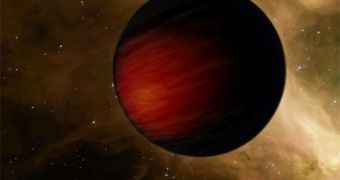A new astronomical find gives a whole new meaning to the phrase "it's a hell hole." The Spitzer Space Telescope has just sent in astonishing new data about the most bizarre extrasolar planet ever photographed.
It literally fits the classical descriptions of Hell: the temperatures on the surface of this planet reach a scorching 2040 degrees Celsius (3700 Fahrenheit), almost as hot as some small stars.
Another strange feature of the newly discovered planet is that it's pitch black, the fact that it does not appear to reflect any starlight suggesting it must be blacker than charcoal.
What's even stranger about this alien world is the fact that because it is so hot, it may glow like an ember.
Astronomers are puzzled, as they have no answer for a question: why is the weird planet so hot? "What we found is that it was not just a hot planet, which we expected, but that it was really hot," says team leader Joseph Harrington, an astronomer at the University of Central Florida in Orlando, US.
"A lot of people are going to be scratching their heads trying to figure this out," Harrington says.
The planet has been named HD 149026b and it's orbiting 25 times closer to its star than Earth does to the Sun.
And the extremely unusual characteristics don't stop here! The dark planet is also extremely dense and it's believed to contain more heavy elements than all of the bodies in our solar system, excluding the Sun.
The solid core of HD 149026b has been calculated to have a mass of 70 to 90 Earths. Scientists have tried explaining the fact that it's so hot and black by the fact that some chemicals in its atmosphere might efficiently absorb and trap sunlight and thus heat up the planet and they suspect it's a layer of titanium oxide.
However, at such extremely high temperatures, titanium should condense and fall from the atmosphere in the form of rain.
The planet that resembles Jupiter has a orbiting period of only 2.2 days, is closer to its star than Mercury and it always shows the same side to the star, much like the Moon shows the same face to Earth, which makes one side of the planet have a continuous daytime, and the other, an eternal dark night.
Another interesting fact is that it's also the closest transiting planet to Earth, being located at only 60 light years away.
And for the final touch, the planet disappeared behind the star it orbits two minutes later than astronomers had calculated if it had a perfectly circular orbit. This could mean that there might be other small planets lurking in the dark, that the telescopes were not able to detect so far.

 14 DAY TRIAL //
14 DAY TRIAL //